
Smaller Chip Firms Seen as Value Plays
Smaller Chip Firms Seen as Value Plays
by Hal Plotkin
Silicon Valley Correspondent
With major semiconductor-manufacturing stocks such as Applied Materials Inc. {AMAT}, KLA-Tencor Corp. {KLAC}, Lam Research Corp. {LRCX}, and Novellus Systems Inc. {NVLS} trading at or near record levels, analysts say that now is a good time to scoop up the stocks of second-tier firms operating in the same fast-growing sector.
“The truth is the major semiconductor-manufacturing stocks have had a hell of a run,” says Michael Murphy, publisher of the California Technology Stock newsletter. Murphy recommended buying many of the major semiconductor-manufacturing stocks last year when their prices were significantly lower than they are today.
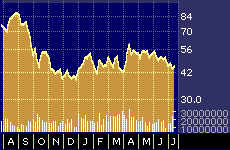
One-year performance chart for AMAT
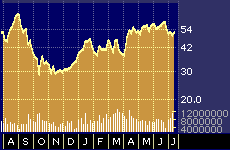
(left) & KLAC
“We’re basically telling people they can hold on to these stocks [large semiconductor-manufacturing equipment makers], and they will be higher next year,” Murphy says. “But right now I’d go in between. The question for investors now is who has products that are being bought today. Mattson is very strong in Taiwan where we are seeing a lot of growth. And Cymer, which makes lasers used in semiconductor manufacturing, is really going to do well over the next few years as the size of chips gets smaller.”
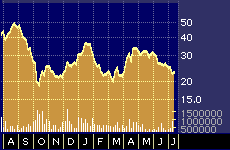
One-year performance chart for CYMI

(left) & MTSN
Murphy says Cymer Inc. {CYMI} and Mattson Technology Inc. {MTSN} are likely to give investors better returns over the near term, compared with their larger competitors whose stock prices, he says, have gotten somewhat ahead of themselves.
Fremont, Calif.-based Mattson, which is broadening its product line, is already the leading independent supplier of technology used to strip unneeded materials off a computer chip after it has been exposed to light in the manufacturing process. Cymer, based in San Diego, is the dominant supplier of 248 nanometer lasers used in the most-advanced semiconductor-manufacturing plants.
“I’m looking for Mattson to beat earnings expectations later this month,” says Eric Chen, an analyst at Hambrecht & Quist, based in New York. “They broke even last quarter. I’m expecting them to significantly grow their top line and bottom line in this environment.” Chen currently has a “buy” rating on the stock.
Chen says he agrees with Murphy about the wisdom of buying the stocks of smaller, more niche-oriented semiconductor-manufacturing equipment makers. “The bigger companies continue to get bigger,” he says. “They are well-managed, particularly Applied Materials and KLA-Tencor. But the opportunities for second-tier names from a value perspective are even more attractive.”
In terms of Cymer, it is “an absolutely essential dominant supplier of a critical component,” says Cristina Osmena, an analyst at Needham & Co., based in New York. “Cymer’s stock continues to have upside potential, even though it’s at a 52-week high. I think this year is going to be the best year of the growth cycle.”
Osmena currently has a “buy” rating on the stock and is in the process of revising the $50 price target set by her firm last October. “It’s definitely still a good long-term play,” she says.
Osmena says she expects Cymer will also be the dominant supplier of the next-generation of even-smaller wavelength lasers that will be used to create steadily shrinking chip geometries. “They already have a huge mind-share and can leverage off their dominant position,” she says.
Osmena also likes Brooks Automation Inc.’s {BRKS} stock at its current price level.
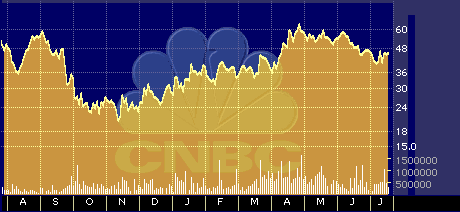
One-year performance chart for Brooks Automation Inc.
The company, based in Chelmsford, Mass., makes vacuum robotics used in process tools. Osmena says Brooks Automation is also well-positioned to benefit from the expected avalanche of new spending on semiconductor-manufacturing capacity. “Although the stock has run up some already, it’s kind of like a Cymer,” she says.
Fred Wolf, a director of research at Boston-based Adams Harkness & Hill, takes a somewhat contrarian view. He agrees that the stocks of the major chip manufacturing-equipment makers don’t currently offer the best values in the sector. But he says investors should look even further down the the food chain for stocks that will offer the most handsome returns over the near term.
“I think Cymer’s stock, for example, is already fairly valued,” Wolf says. “It’s selling at a discount compared with the larger firms but not a dramatic discount.”
Wolf says he is considerably more enthusiastic about ADE Corp. {ADEX} and Varian Semiconductor Equipment Associates Inc. {VSEA}.
Wolf has “buy” recommendations on both stocks with a three-to-six month price target of $32 on ADE and $50 on Varian Semiconductor Equipment.
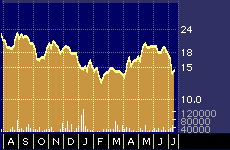
One-year performance chart for ADEX
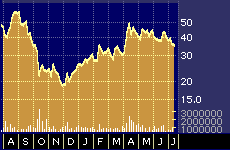
(left) & VSEA
“They are not particularly well-known names with a small market cap,” Wolfe says. “But they are dramatically undervalued compared to the bigger stocks. Their stock prices don’t reflect their real earnings potential over the current cycle.”
Westwood, Mass.-based ADE makes equipment that tests semiconductors wafers and related products while Varian Semiconductor Equipment, based in Gloucester, Mass., is a leading supplier of ion implanters used in semiconductor manufacturing.
Analysts say their optimism about stocks in this sector is based upon almost unprecedented strong demand in their core markets.
The worldwide wafer fabrication equipment market is expected to generate revenue of $25 billion in 2000, an increase of 43.5 percent over last year, according to a recent report by Dataquest, based in San Jose, Calif.
“The return to a relative balance of capacity and demand and stable pricing will bring two to three additional years of strong expansion,” says Clark Fuhs, an analyst at Dataquest.
“Over the next 12 months there certainly are some good opportunities,” agrees Mike O’Brien, an analyst at SoundView Technology Group, based in San Francisco. “Business is great and getting better and it could go on until 2003.”
“I’ve been following these stocks for 30 years,” Murphy adds. “And I’ve never seen a time when you could project growth like this.”
Murphy says the upturn is linked to several advances in the chip-manufacturing process, including the movement from 0.25 to 0.18 chip geometries, the switch from aluminum to copper-based chips, and the introduction of larger 12-inch silicon wafers, all of which require new manufacturing equipment. “It’s going to be a four-year run,” he says.
Jay Deahna, an analyst at Morgan Stanley Dean Witter, based in New York, also likes the sector, but with a much shorter-term horizon. Deahna says investors would be wise to get into the semiconductor manufacturing equipment maker stocks at their current levels, even the big firms, but he adds they should keep their powder dry.
“They should outperform the market for the first half of this year,” Deahna says. “But investors should be ready to take profits toward the middle of the year. They’ll probably underperform in the second half,” he warns.
Mattson, Deahna notes, has doubled over the past few weeks while Cymer is up more than sixfold since October 1998. “Mattson is playing catch-up rapidly,” he says. And with Cymer, “I don’t think they will outperform the group, but I do think they make a lot of sense for the first half of this year.”


